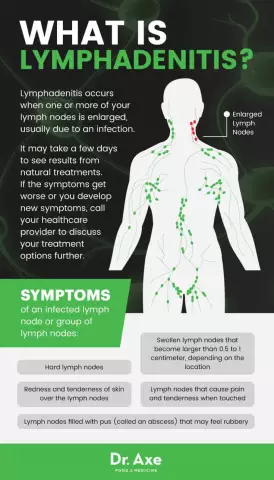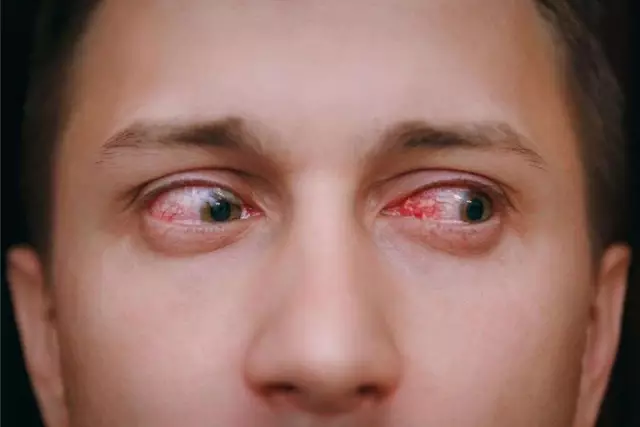- Author Rachel Wainwright [email protected].
- Public 2023-12-15 07:39.
- Last modified 2025-11-02 20:14.
Axillary lymphadenitis

Axillary lymphadenitis is an inflammation of the lymph nodes caused by the bacteria staphylococcus and streptococcus, which enter them from the phlegmon of soft tissues or panaritium. Much less often, inflammation occurs due to the direct ingress of bacteria directly into the lymph nodes through trauma to the skin.
The lymph nodes located in the armpit area filter the lymphatic vessels of the shoulder girdle, arms, abdominal organs (those located above the navel) and chest organs, which are sources of infection that spreads through them to the armpit area.
Causes of axillary lymphadenitis
The main reasons for the appearance of axillary lymphadenitis are such sources of infections in the body as:
- · Phlegmon;
- · Infected scrapes and wounds;
- · Osteomyelitis;
- · Trophic ulcers;
- · Erysipelas;
- · Boils.
Also, inflammation of the lymphatic vessels can be the cause of inflammation of the lymph nodes. The causative agents of axillary lymphadenitis in most cases are:
- Escherichia coli;
- · Proteus;
- · Streptococci and their toxins;
- · Enterococci and their toxins;
- · Staphylococci and their toxins;
- · Products of decay of tissues of the primary focus of inflammation.
Symptoms of axillary lymphadenitis
Symptoms of axillary lymphadenitis are expressed in different ways depending on the form of the disease. In acute axillary lymphadenitis, symptoms are severe pain, fever, and enlarged lymph nodes. In cases of destructive forms of axillary lymphadenitis (purulent inflammation), symptoms of intoxication appear.
In the chronic form of the disease, there is only an increase and cohesion of the lymph nodes among themselves. A simple form of inflammation, which is not accompanied by a purulent process, proceeds with a limited focus of inflammation within the boundaries of the formation capsule. The development of destruction leads to the fact that inflammation begins to spread to the surrounding tissues.
Severe forms of axillary lymphadenitis lead to the development of a purulent-inflammatory process of cellulose (adenophlegmon) with softening foci, which, with ineffective or untimely treatment, spread further with the development of septicopyemia or thrombophlebitis. The breakthrough of pus to the outside can eventually lead to the formation of lymphatic fistulas.
Axillary lymphadenitis treatment

After confirming the diagnosis of axillary lymphadenitis and determining the cause of the inflammation, the doctor determines the stage at which the disease is located and the type of treatment is selected.
Axillary lymphadenitis in the initial stage of development can be treated with the help of conservative treatment, with parallel restorative procedures, physiotherapy and broad-spectrum antibiotics, and cold compresses are applied to the inflamed nodes.
In the treatment of axillary lymphadenitis with purulent inflammation, surgical intervention is necessary. The operation consists of opening the lymph node and removing purulent masses from it, after which drainage is performed. The operation is followed by a therapeutic treatment based on the principles used in the treatment of purulent wounds.
When treating specific axillary lymphadenitis, the doctor takes into account whether there are foci of inflammation in other organs, and traces the general tuberculous process. Treatment of axillary lymphadenitis of this type can last for several months and, in addition to antibiotic therapy, includes injecting the affected node and applying ointment dressings. If a purulent infection joins, then the doctor prescribes additional use of broad-spectrum antibiotics.
YouTube video related to the article:
The information is generalized and provided for informational purposes only. At the first sign of illness, see your doctor. Self-medication is hazardous to health!






